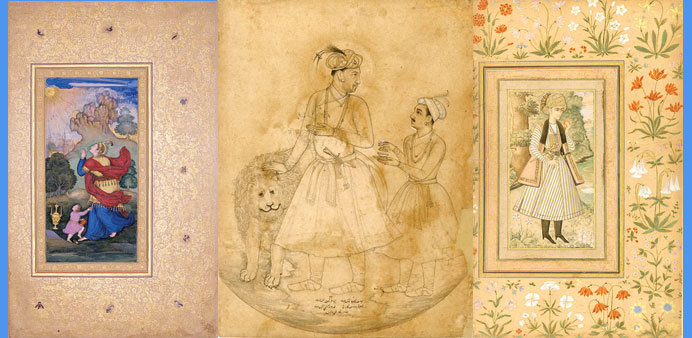Calligrapher Mir Ali’s work titled Classical Figure with a Child, Mughal India, 16th century, Ink, opaque watercolour, and gold on paper; Mughal court artist Balchand’s portrait of the Emperor Jahangir, early 17th century, ink and opaque watercolour on paper and Painted in late Safavid Iran, this is a portrait of a princely youth by artist Ali Quli Jabbadar, ink, opaque watercolour, and gold on paper.
By Anand Holla
After the first part of its Building our Collection exhibition recently came to a close, the Museum of Islamic Art is all set to leap into the second instalment starting September 17.
Ceramics of al-Andulas, which focused on rare and beautiful ceramics from Spain and ended on August 30, highlighted the blending of Muslim and Christian artistic motifs. Now, Mughal and Safavid Albums, the second part of the exhibition, will throw open the museum’s collection of miniature paintings and calligraphic compositions to visitors till February 21, 2015.
The objects that will be on display were once part of Safavid and Mughal-era albums, and “album” is a translation of the Arabic and Persian word muraqqa, which refers to an object patched together.
“Often used as a metaphor for the patchwork of the heavens or the constellations, or referring to the patched cloak of the wandering dervish, this term encapsulates the sophisticated juxtapositions of calligraphy and painting compiled and bound into volumes between the 15th and 19th century, also called muraqqa, the dispersed pages of which are on display here,” says the note on the exhibition.
“The culture of connoisseurship and collecting at the royal courts of the early modern Islamic world can be reconstructed in part through an examination of the methods in which these albums were compiled,” the note further explains.
MIA’s Building our Collection exhibition explores why MIA collects Islamic art, and how its collecting practices shape our understanding of Islamic art through artistic and cultural connections between different regions of the Islamic world.
The note adds, “The careful selection of calligraphy and illustration, and the connoisseur’s appreciation of the interplay between word and image, colour and composition, and the recognition of the hands of particular artists, sheds a great deal of light on the artistic cultures of the Safavid and Mughal courts.”
To enhance the understanding of this fascinating era, MIA will hold a series of talks, tours and workshops. Exhibition curator Dr Nur Sobers-Khan will talk on “Collecting Practices from Iran to India: Safavid and Mughal Albums” at 6:30pm on November 19 at the MIA Auditorium. Before that, she will take visitors to a guided tour of “Paintings for Princes: Mughal and Safavid Albums” on two Thursdays – September 25 and November 6 – at 6pm.
Noted artist Ayesha Gamiet will present a live demonstration of miniature painting on October 31, from 3pm to 5pm, at the MIA atrium. This is your chance to learn first-hand how artists from the past created MIA’s historic manuscripts and painted albums. In the art workshop Miniatures in Focus, for those above 16 years old, you will be taught to create Indian or Persian miniatures, inspired from those on display at the exhibition.
Amelie Couvrat Desvergnes, who works as a paper and book conservator at the MIA, has handled the examination and the conservation treatment of the miniature paintings and concertina albums selected for display. Dr Nur Sobers-Khan, who previously worked as the Iran Heritage Foundation curator for Persian manuscripts at the British library, is the curator of this instalment of the exhibition.



